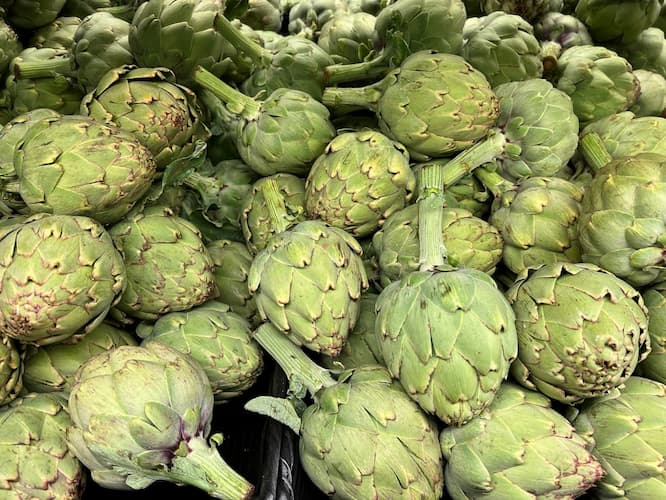How to Grow Globe Artichoke

About Globe Artichoke
Artichokes or “chokes” as they are commonly called, are a member of the thistle family. Globe artichoke is a sensuous vegetable and the vegetable of the gods. The Greek god Zeus loved artichokes. Aso, aristocrats and affluent members of society have enjoyed artichoke hearts for thousands of years. Growing artichoke plants requires a long growing season as well as warm weather.
The Artichokes we eat, are the immature flower bud of the plant. This tender, young bud is the “Artichoke Heart”. Mature buds produce a purple flower. However as mentioned above, people eat immature buds. As a result, we don’t see this plant in full bloom too often.
Eat Artichoke hearts raw or cooked. They are most often steamed. Eat the heart, or center of the bud along with small, tender outer leaves. The stem is also edible. Cut it up to an inch or so below the bud.
Artichoke is native to the Mediterranean and North Africa. The plants require a long, warm growing season.
Did you know? Artichokes are a member of the Thistle family.
California is the almost exclusive grower of commercially grown Artichokes in the U.S. Home gardeners grow them. But, it is not a common home-grown crop. It is also grown around the world.
Other Names: Cardoon
Ancient Greek Myth: Women who want to have a boy eat artichokes.
Varieties of Globe Artichoke
There are over one hundred varieties of Artichoke grown around the world. Of those, about 40 varieties are grown commercially. Yet, there are only a couple of common garden varieties.
Globe Artichokes are grown for their edible flower. Another Artichoke, Jerusalem Artichokes are grown as a tuber, like a potato.
Did You Know? In 1948, Norma Jeane Mortenson was crowned California’s first Artichoke Queen. Norma Jeane went on to be a famous actress under the name Marilyn Monroe.
How to Grow Globe Artichoke
Artichoke plants are perennials. Importantly, they will rarely produce flowers in the first year. Plant them in an area of your garden where they can grow for years.
Initially, sow seeds one inch deep spaced 5-6 inches apart, in rows 5-6 feet apart. Ideally, thin plants to two 2 1/2 feet apart.
Also, See:
Soil Temperatures – Ideal germination temperature by vegetable
Ideal Soil pH – by vegetable
How to Grow Globe Artichoke - Insects and Plant Disease
Slugs like the young, tender shoots. Furthermore, insect problems are the worst in wet weather. In addition, Aphids like to suck on the flower buds and stems as they are developing.
Blight on the petals of the flower can occur, too. Treat with a fungicide early.
Harvesting Artichokes
Days to Harvest: 180 – 365
Harvest Artichoke buds just before the bud begin to open. Cut the main bud a few inches below the bud. Smaller secondary buds form later. Harvest these smaller buds, too.
Plan ahead. Artichoke plants produce the first bud in 1-2 years.
Unharvested buds produce big, beautiful, purple flowers. The garden will look pretty, if you miss the harvest.
Plant Hardiness
Artichoke plants need a long growing season and mild weather areas. Winter protection requires applying a thick layer of mulch in colder regions. Consequentially, we don’t recommend growing them in northern climates, as the season is too short.
Globe Artichoke Trivia
- Artichokes are one of the world’s oldest known vegetables.
- Incidentally, the part of the Artichoke plant we eat is the unopened flower bud.
- In fact, there are over 100 varieties of artichoke grown around the world.
- Actually, one mature artichoke plant can produce up to 20 artichoke buds.
- Additionally, Artichokes contain more antioxidants than any other vegetable.
Globe Artichoke Recipes
Please support our site. Shop for:
- rmmatthews100@hotmail.com
- 585-721-6528
- Rochester, NY
©1999-2024 GardenersNet.Com, All Rights Reserved

